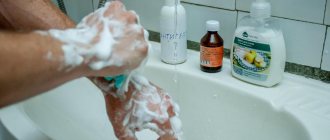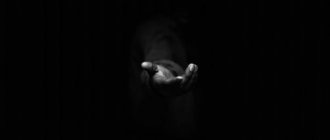Pathogenesis
Mysophobia may be a manifestation of obsessive-phobic symptoms of schizotypal personality disorder . As the main components of the syndrome, obsessive fear of pollution and fear of germs can be exacerbated under certain conditions, causing patients to become antisocial and isolated. For example, Mayakovsky had an eccentric habit of carrying disinfectant in his right pocket, which he used immediately after shaking hands.
Initially, a phobia is formed in a pathogenic situation, intensifies under the influence of memories and fills all thoughts, turning into obsession and developing like conditioned reflexes.
Symptoms
As a result of obsessive fears, neurasthenia or neurosis may develop, and also manifest itself in the form of the following symptoms:
- increased irritability and/or tearfulness, as well as other manifestations of hyper-emotionality;
- attacks of suspiciousness and anxiety;
- depressed mood and thoughts;
- sleep disorders;
- fatigue and decreased ability to concentrate for long periods of time;
- difficulties adapting to a team;
- motor retardation;
- idiopathic muscle spasm or tremors ;
- vegetative-vascular disorders, including headaches, increased sweating of the palms, fainting , shortness of breath appetite disturbances and disorders of the digestive system.
In addition to physiological and mental disorders, patients develop a system of protective rituals. In mysophobes, the fear of dirt is expressed in an obsessive desire for cleanliness and disgust:
- constant hand washing and use of disinfectants;
- avoiding public restrooms, transportation, or other common items;
- disgust towards contact with animals, close relationships and physical contact with people;
- frequent change of clothes and linen to clean ones;
- the desire for self-isolation, including avoidance of social events, lack of desire to get close to anyone;
- constant use of personal hygiene products, gloves, masks, etc.;
- too frequent general cleaning of the house with a large number of different expensive cleaning products.
Causes
Obsessive states and fears usually develop as a result of a long-term psychotraumatic situation. Most often, the fear of dirt is perceived as an extracorporeal threat and is caused by obsessive thoughts and fears for one’s health or for one’s loved ones, which can be triggered by unpleasant memories or ideas.
The object of a phobia is a symbolic projection of real objects that were associated with traumatic situations, anxiety, or separation of the child from his parents. Thus, to trigger neurosis , repetition of traumatic events is sufficient, for example, anticipation of the moment of separation from the object of attachment.
In addition, the following are considered predisposing factors for the development of mysophobia:
- inculcation by the media of the need for constant maximum cleansing of one’s homes and body;
- suggestibility and psychological imbalance;
- strict education and lectures on the horrors of pollution and poor hygiene;
- hypochondriacal personality type;
- hereditary depression ;
- examples of negative experiences among people in a close circle of friends, for example, contracting AIDS from a needle in public transport;
- increased sense of perfectionism and desire for self-improvement.
Development of a phobia
The fear experienced by a person, aimed at fear of contact with dirt and pathogenic microorganisms, manifested in excessive cleanliness, is called mysophobia.
The development of this condition includes several stages.
- The person’s first thoughts arise that at any moment it is possible to become infected with microbes or a serious disease.
- A person washes his hands more often and keeps his surroundings clean.
- Doubts arise whether the hands are really washed well and how clean the objects in the environment are.
- There is a need for better cleaning as well as disinfection of everything around the person with the phobia.
- Relief comes, which is temporary.
- A person begins to fear not only for himself. He worries that he could become a carrier of infection and harm his loved ones. Therefore, he is protected from any communication.
Mysophobia: treatment
Treatment of mysophobia as part of neurosis is most often based on a combination of individual cognitive behavioral psychotherapy and temporary medication (antidepressants). The latter are prescribed when the neurosis continues for several years. This is basically what happens: the disease develops slowly, gradually, at first it does not spoil life very much and is perceived as personality traits, for example, neatness, cleanliness, disgust, caution. Years pass before a person asks himself the question: how to get rid of mysophobia and turns to a specialist. Self-treatment is unlikely to be successful, because, as I have already written, people come to the conclusion that it is necessary when everything has been going on for more than one year. In addition, personality traits that predispose to this form of anxiety disorder cannot be corrected without a psychotherapist. Some people believe that character cannot be changed. But it is not so. At the very least, a lot can be smoothed out. There are two films that portray mysophobia well: The Aviator with Leonardo DiCaprio and Best Offer with Geoffrey Rush.
Classification
Mysophobia is not a classic example of the fear of getting sick ( nosophobia ) or due to contact with dirty objects, dust, fear of contracting helminths or other infections, while fear and fear may concern the following objects:
- chemicals, patients may fear radiation ( radiophobia ) or other chemical contamination;
- small objects - fragments ( oxyphobia ), rusty nails that may be in dirt, earth, sand, etc.;
- sewage – ripophobia ;
- fear of dirt and the germs contained in it ( spermophobia );
- non-washable items, furniture and rooms in general, which, even if they look clean, may be second-hand, dusty ( amatophobia ) or truly dirty.
How to become a mysophobe?
In modern times, with a large flow of information from the media, it is not easy to maintain peace of mind. It is very easy to become a mysophobe: people become anxious when watching a certain type of news, television programs that report new strains of influenza and high mortality rates from it or other infections. Mysophobia can come from childhood, when worried parents, with every slight contamination of the child, “drag” him to wash and constantly talk about dangerous microbes swarming around.










